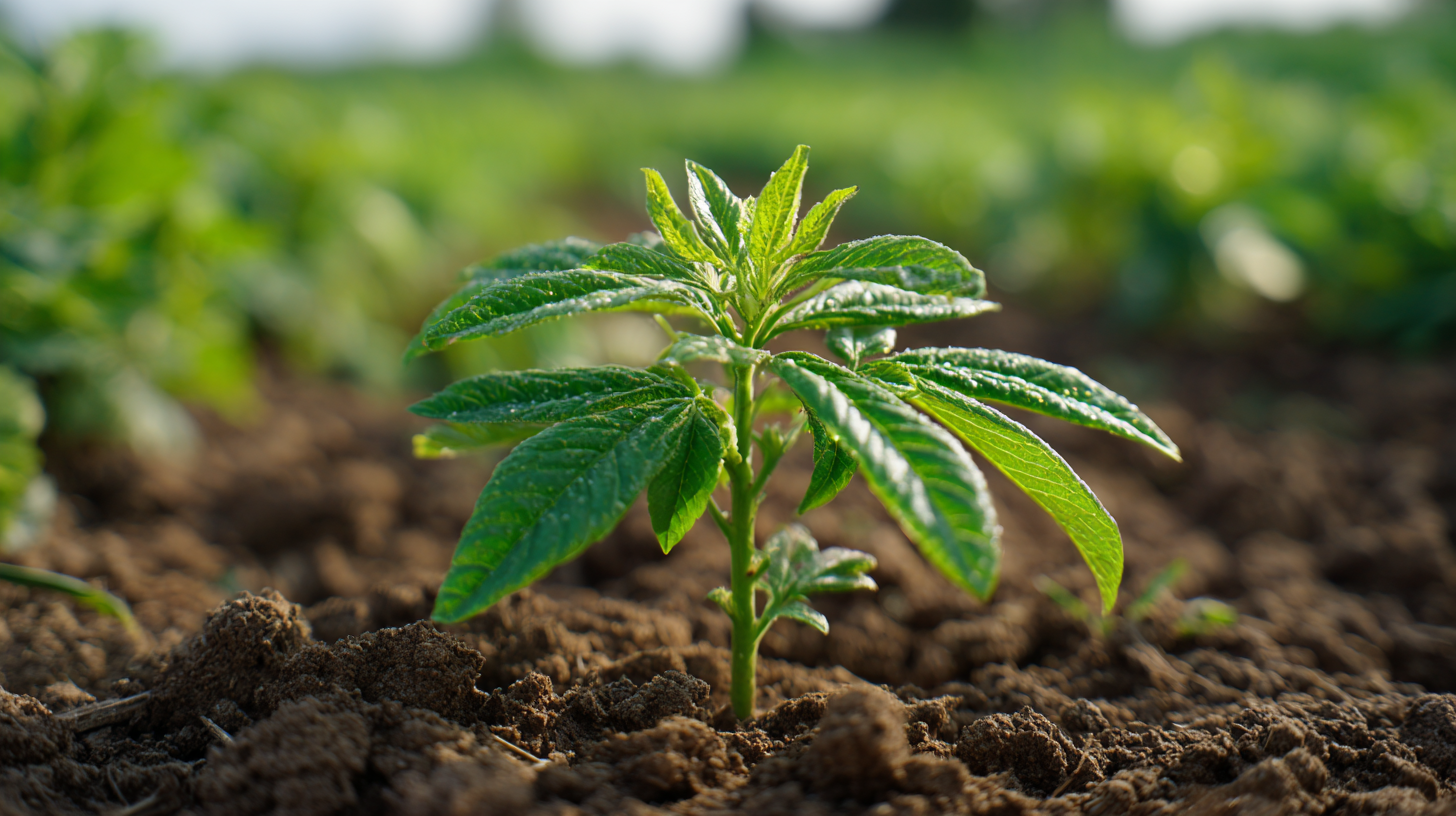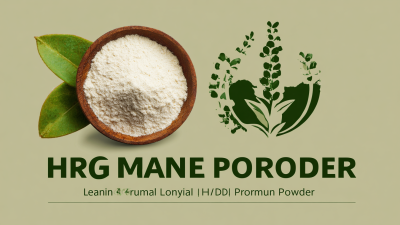In the quest for sustainable agriculture and enhanced crop yields, “Plant Hormone Powder” has emerged as a promising solution. According to a report by the Food and Agriculture Organization (FAO), global food production needs to increase by 70% by 2050 to meet the demands of a growing population, making innovative agricultural practices essential. Plant hormones, such as auxins, gibberellins, and cytokinins, play critical roles in regulating plant growth and development. Recent studies indicate that the application of plant hormone powders can significantly improve crop yield—by up to 30% in some cases—while reducing the need for chemical fertilizers and pesticides. This shift not only boosts productivity but also aligns with the growing consumer demand for sustainably sourced food. By unlocking the potential of plant hormone powder, farmers can adopt more effective, environmentally-friendly practices that contribute to both ecological health and food security globally.

 Plant hormones, or phytohormones, play a crucial role in regulating various physiological processes in plants, influencing their growth and development. These naturally occurring compounds, such as auxins, gibberellins, cytokinins, and ethylene, are fundamental to crop production. By understanding and manipulating these hormones, farmers can enhance seed germination, root development, and overall plant vigor, ultimately leading to improved crop yields. For instance, the application of gibberellins can break seed dormancy and promote faster germination, while auxins can stimulate root growth, enhancing the plant’s ability to absorb nutrients and water.
Plant hormones, or phytohormones, play a crucial role in regulating various physiological processes in plants, influencing their growth and development. These naturally occurring compounds, such as auxins, gibberellins, cytokinins, and ethylene, are fundamental to crop production. By understanding and manipulating these hormones, farmers can enhance seed germination, root development, and overall plant vigor, ultimately leading to improved crop yields. For instance, the application of gibberellins can break seed dormancy and promote faster germination, while auxins can stimulate root growth, enhancing the plant’s ability to absorb nutrients and water.
Moreover, the use of plant hormone powder aligns well with sustainable agriculture practices. By leveraging these hormones, farmers can reduce reliance on synthetic fertilizers and pesticides, leading to less environmental impact. Hormone treatments can promote resilience against stressors such as drought or disease, allowing crops to thrive in less-than-ideal conditions. Additionally, harnessing the power of plant hormones can contribute to a more efficient use of resources, supporting the transition towards more sustainable food production systems. As research advances, the potential applications of plant hormones in agriculture will likely expand, offering innovative solutions to enhance food security and environmental stewardship.
Plant hormones, also known as phytohormones, play a crucial role in regulating various aspects of plant growth and development. There are five main types of plant hormones: auxins, gibberellins, cytokinins, abscisic acid, and ethylene, each serving distinct yet interrelated functions. Auxins are primarily involved in cell elongation and differentiation, facilitating phototropism and gravitropism, which are essential for optimal light capture and root growth. Gibberellins promote stem elongation, seed germination, and flowering, making them vital for enhancing fruit size and crop yield.
Cytokinins, on the other hand, are instrumental in promoting cell division and delaying leaf senescence, thus playing a significant role in maintaining plant health and resilience. Abscisic acid acts as a stress hormone, regulating processes like stomatal closure during drought conditions, thereby aiding in water conservation. Lastly, ethylene is known for its role in fruit ripening and senescence, influencing maturity and post-harvest quality. Understanding the specific functions of these hormones enables farmers to utilize plant hormone powders effectively, promoting healthier crops and supporting sustainable agricultural practices.
This chart illustrates the impact of various plant hormones on crop yield enhancement. The data highlights the significance of different hormones in sustainable agriculture practices.
Application methods for plant hormone powders are crucial for maximizing their effectiveness in crop management. One common approach is the foliar spray technique, where diluted hormone solutions are applied directly to the leaves. This method ensures rapid absorption and can lead to immediate physiological responses, such as enhanced growth rates and improved stress resilience. Timing is critical; applying hormones during key growth stages can significantly influence yield outcomes and overall plant health.
Another effective application method is soil drenching, which involves applying the hormone powder mixed in water directly to the soil. This method targets the root system, promoting root development and nutrient uptake. Soil drenching is particularly beneficial for crops in nutrient-poor soils, allowing for a more efficient use of available resources. Additionally, the incorporation of hormone powders into seed treatments can facilitate early germination and vigor, setting the foundation for healthier crops. Each application method harnesses the potential of plant hormones to contribute to sustainable agricultural practices by boosting crop yields and optimizing input resource management.
The use of plant hormones, or phytohormones, has gained significant attention in sustainable farming practices due to their ability to enhance crop yields while promoting environmental stewardship. These natural substances regulate various physiological processes within plants, influencing growth, development, and responses to stress. By optimizing plant growth through hormone applications, farmers can achieve higher productivity without relying heavily on chemical fertilizers, thus reducing the ecological footprint of agricultural practices.

Moreover, incorporating plant hormones into farming systems can improve soil health and biodiversity. For instance, when plants are treated with hormones such as auxins or gibberellins, they exhibit better root development, which enhances nutrient absorption and soil structure. This not only supports healthier plants but also contributes to the overall resilience of the ecosystem. Additionally, sustainable agriculture emphasizes the importance of crop rotation and polyculture, which can be further enhanced with the strategic application of plant hormones, leading to more robust and diverse agricultural systems that mitigate risks associated with pests and diseases.
In recent years, the application of plant hormone powders has emerged as a transformative strategy for enhancing crop yields while promoting sustainable agricultural practices. Numerous case studies have highlighted the effectiveness of these powders in optimizing crop growth. For instance, a study by the International Journal of Agronomy found that the use of auxin-based hormone powders resulted in a 20% increase in tomato yield under controlled conditions, demonstrating significant potential for maximizing agricultural output while utilizing fewer resources.
Another compelling example comes from a field trial conducted in India, where the application of gibberellin hormone powder on rice crops led to a remarkable increase in grain size and overall yield, showing a 15% improvement compared to untreated control groups. This aligns with findings from the Food and Agriculture Organization, which reported that hormonal treatments can reduce the necessity of chemical inputs, thereby enhancing the sustainability of farming practices. With these success stories, it's evident that harnessing the power of plant hormone powders can play a crucial role in meeting the global food demands while caring for our environment.
| Crop Type | Hormone Powder Used | Yield Increase (%) | Sustainability Impact | Region |
|---|---|---|---|---|
| Corn | Auxin | 20% | Reduced Pesticide Use | Midwest, USA |
| Tomato | Gibberellins | 15% | Improved Soil Quality | California, USA |
| Wheat | Cytokinins | 25% | Water Conservation | Eastern Europe |
| Rice | Ethylene | 30% | Better Crop Resilience | Southeast Asia |
| Potato | Brassinosteroids | 18% | Reduced Chemical Fertilizers | Northern Europe |






